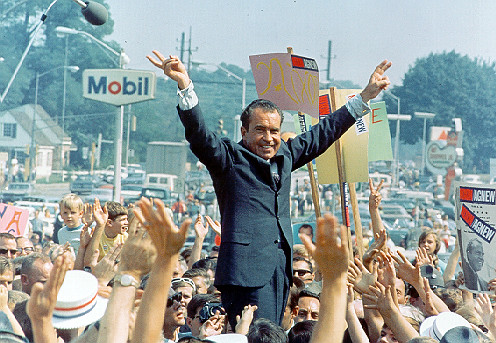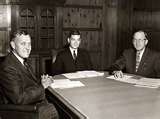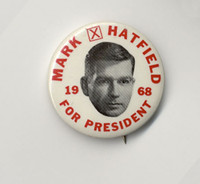Mark Hatfield, former U.S. Senator, Governor, Secretary of State and the class act of Oregon politics for more than 40 years, died today after a long illness. He was 89 and had returned to Oregon after several months of hospitalization at the National Institutes of Health in Bethesda, Maryland.
The dean of moderate Republicans, Hatfield fused deep Baptist beliefs with a knack for retail politics and matinee idol looks into a political career marked by his strong pacifism and extraordinary longevity. And, as chair of the Senate Appropriations Committee, Hatfield displayed a virtuoso skill in bringing home billions of dollars.
The dean of moderate Republicans, Hatfield fused deep Baptist beliefs with a knack for retail politics and matinee idol looks into a political career marked by his strong pacifism and extraordinary longevity. And, as chair of the Senate Appropriations Committee, Hatfield displayed a virtuoso skill in bringing home billions of dollars.
Hatfield was born in Dallas, Oregon, an only child whose father was a railroad blacksmith and whose mother was a teacher. Hatfield's parents were religious (his father also taught Sunday school) and his mother was both domineering and terrifically ambitious for her son.
Hatfield attended Willamette University and graduated in 1943, after three years of school. He served in the U.S. Navy, took part in Iwo Jima and arrived in Hiroshima after its bombingâan event that had a profound effect on Hatfield and his later politics. He returned to the states, received a graduate degree in political science at Stanford, moved to Salem and within ten years, was elected Governor in 1958 at the age of 36, the youngest person ever to serve in that office.

Credits: IMAGE: Steve Morgan
Hatfield's turbo-charged rise in state politics (he served in the legislature, as Secretary of State and two terms of Governor) was marked by his oratorical skills and a singular kind of charisma that was at once aloof and magnetic. He earned a reputation as an unusually spiritual politician and, even more atypically, an independent one.
Hatfield lacked a certain attention to detail, but was fortunate to team up with Gerry Frank, the scion of a department store fortune and an organizational whiz. The two men met in Salem when Hatfield was in the legislature and The Oregonian did a story on the two most eligible bachelors in Salem: Hatfield and Frank. The first meeting occurred when a newspaper photographer asked them to pose together. Frank began to work with Hatfield and ultimately became his closest adviser and chief of staff.
Hatfield lacked a certain attention to detail, but was fortunate to team up with Gerry Frank, the scion of a department store fortune and an organizational whiz. The two men met in Salem when Hatfield was in the legislature and The Oregonian did a story on the two most eligible bachelors in Salem: Hatfield and Frank. The first meeting occurred when a newspaper photographer asked them to pose together. Frank began to work with Hatfield and ultimately became his closest adviser and chief of staff.
Hatfield held positions occasionally difficult to reconcile. He was one of the first elected officials in overwhelming white Oregon to push for civil rights legislation (he supported a public accommodations bill in 1953 after Paul Robeson and Marian Anderson performed in Salem yet had to spend the night in Portland because Salem's hotels had a "No Coloreds" policy). Yet he also sponsored a bill requiring public school teachers to acknowledge past or present connections to the Communist Party.
He opposed abortion, yet he also supported a state-wide birth control program. He was a devout Baptist who married Antoinette Kuzmanich, a Catholic (In 1958, that was a big deal. As a result of the union, a Catholic newspaper refused to carry Hatfield's political ads when he ran for governor).
As a candidate and elected official, Hatfield was remarkably skilled. He was the master of the small gesture, could remember (with Frank's help) thousands of people's names and had a bearing and manner that elicited respect. He was quite different from the other best-known Oregon politician of his generation, the late Governor Tom McCall, who was gregarious, funny, liked the bottle, and would just as soon hug you as shake your hand. Said McCall himself, "we have a completely different kind of chemistry. He's like a cat and I'm like a dog. I'm open and forthright and Mark is distant and tremendously politically oriented. Still, I have always thought of Mark as one of the most capable people in public life ..." The two men, according to Gerry Frank, "did not have a close relationship."
Part of Hatfield's success was that he looked the part. Strikingly handsome, he had an almost dandyish sense of fashion, (Fellow Republican and friend Norma Paulus once said that she had never seen Hatfield "outside of a tie.") Hatfield, in the words of Daily Astorian editor Steve Forrester "was like a beautiful woman. You assumed he wasn't smart. But he was. Very." Hatfield, for many years, hung a large oil portrait of himself in his Georgetown bedroom.
By the early 1960's, he was in his second term as Governor and, unusual for an Oregonian, had established a presence on the national political stage, in part because of his growing opposition to the Vietnam War, a position that was a genuine profile in courage. In 1966, at the National Governors' Association annual meeting, then-president Lyndon Johnson had asked for a resolution of support for the war. Hatfield made national headlines and earned a number of enemies when he became the only governor among 50 who voted against the resolution.
In the fall of 1966, Hatfield ran for the United States Senate against Democratic Congressman Robert Duncan, who attacked Hatfield for his "dovish" views and famously stated that if we don't fight communists "in the elephant grass of Southeast Asia, then we will have to fight them in the rye grass of the Columbia River Basin." The state's senior Senator, Democrat Wayne Morse, crossed party lines and endorsed Hatfield, who won by 24,000 votes.
Two years later, in the tumult that was 1968, Hatfield seemingly turned on his anti-war position when he supported the candidacy of Richard Nixon for president over that of the more liberal New York Governor Nelson Rockefeller. Nixon was a hawk and strong supporter of the war in Vietnam. Hatfield explained at the time that there was nothing inconsistent about his position; instead he believed that "Nixon represented the greatest hope for resolving the war." Nixon went on to win the Oregon primary on May 28, later telling people that this victory tied up the Republican nomination for him.


Not long after, Hatfield made the short list of vice-presidential candidates (The Reverend Billy Graham lobbied Nixon on behalf of Hatfield), though Nixon ultimately chose Maryland Governor Spiro Agnew, a pol who was far from Hatfield in both politics and polish. Many believe that Hatfield's support of Nixon was a moment when Hatfield's national ambitions got in the way of his deeply held anti-war beliefs.
After Nixon was elected president, Hatfield continued his anti-war agitation. He spoke around the country in opposition to the war and in 1970 drafted a get-out-of Vietnam amendment with South Dakota Democrat Senator George McGovern, as Nixon ordered U.S. forces to invade Cambodia. The measure lost. Hatfield toyed with the idea of a presidential bid, but demurred. McGovern did run against Nixon in 1972, and lost.
Hatfield's anti-war views remained throughout his career. He opposed the Gulf war, never voted for a military authorization bill, was an early opponent of the draft and was a regular sponsor(with Massachussetts Senator Ted Kennedy) of nuclear freeze bills.
These positions were not the only ones in which Hatfield cut against the grain of his Republican colleagues (and often Democrats as well). He opposed efforts to institute school prayer, disliked term limits and opposed an effort to pass a balanced budget amendment. He tried to pass a federal bottle bill, supported a federal shield law for reporters, proposed banning from farming any company with assets more than $3 million and, in response to the energy crisis of 1973, favored the elimination of the oil depletion allowance, a huge tax benefit for the oil industry.
As Governor and later as U.S. Senator, Hatfield was close to the timber industry, in those days a force to be reckoned with. He supported large cuts of timber off of federal land, and fought environmentalists and supporters of land use reform. He faced a real challenge in his 1990 reelection campaign against Bend businessmen Harry Lonsdale, who attempted to portray Hatfield as a tool of big timber, prompting Hatfield, for the first time in his political career, to air negative advertisements about his opponent. The campaign revealed that when he needed to be, Hatfield could be extremely tough. Here's how Hatfield, in his memoirs, characterized Lonsdale, who owned a tech business in Bend. "Lonsdale served as a supreme example of the political-industrial complex. He had money, wealth, and the capacity to spend it . . .here Lonsdale was, portraying himself as a small businessman against big government, when in fact his business had been born and bred off government grants. While fashioning himself as an environmentalist, he regularly dumped dangerous chemicals down the drain of his own lab." Says Tom Imeson, who worked for Hatfield for many years, "He was a very principled person. But he could be very tough from a political perspective."
While there was little doubt that he was cozy with timber companies, Hatfield also took pride in supporting the expansion of the state parks system, investing in fish conservation and establishing a number of federal wilderness areas. One of his greatest environmental accomplishments was the 1986 creation of the federally protected Columbia River Gorge National Scenic Area, an effort that capped decades of legislative attempts.
No elected official brought home more bacon to Oregon than Mark Hatfield.
For eight years, he chaired the Senate Appropriations committee (a result of his seniority and the fact that he was very popular with his colleagues). He used his position as head of the committee through which every federal dollar other than entitlements has to pass to help develop much of the state, from the Hatfield Marine Science Center in Newport to much of the federal funding for Portland's light rail system to several bridges across the state to Pioneer Courthouse Square. No institution, however, benefited more than Oregon Health and Science University, the state's medical school and leading research institution. When Hatfield's daughter Elizabeth was admitted to the medical school in 1989 via a "special admissions process," critics screamed foul and two members of the admissions panel resigned. Others thought it was the least OHSU could do for Senator Hatfield.
While Hatfield used his Appropriations perch to finance a number of worthy investments in Oregon, he could also fall victim to the arrogance of building something just because he could. There may be no better example than Elk Creek Dam in the Rogue River basin in southern Oregon, a structure that Hatfield shoved down the throats of Oregonians, even though most stakeholders, including the federal Army Corps of Engineers, thought it a bad idea, one that would kill fish, alter river temperatures, do little for flood controlâin other words, a colossal waste of money and a first-rate environmental boner. Two years ago, 22 years after construction started on the dam, not even Congress could avoid the harsh reality of the lunancy of Elk Creek and the dam was finally breached, though portions of it remain on the river, a testament to the misguided hubris of federal authority.
Despite his reputation for rectitude and integrity, (his nickname was "Saint Mark"), Mark Hatfield endured his share of scandal. In the early 1980's, columnist Jack Anderson reported that Hatfield aided Basil Tsakos, a shadowy Greek businessman. Tsakos had a scheme to build an oil pipeline across North Africa and sought Hatfield's help. At virtually the same time Hatfield was introducing Tsakos to those who might help him (including Portland native and federal Energy Secretary Donald Hodel), Hatfield's wife, Antoinette, received $55,000 for real estate consulting fees, the last check coming days after Hatfield wrote a letter supporting the project. Tsakos, who had a criminal record, said the fee was for locating and supervising the renovation of an apartment for him in the Watergate complex, but the seller of the apartment said he had never met Ms. Hatfield. Hatfield apologized and donated the money to charity.
In 1991, Hatfield was the subject of a Federal grand jury inquiry into gifts he received and didn't report from the president of the University of South Carolina, along with a scholarship that the school gave one of Hatfield's sons. The gifts were received at a time when Hatfield was considering a $16 million grant to the university. The inquiry lead to broader questions about Hatfield's financial situation, including the gift of $75,000 (in the form of a forgiven loan) from John Dellenback, a former Oregon congressman, and a similar "gift" from a California businessman. After a Senate Ethics investigation, Hatfield was rebuked by his peers.
Hatfield's transgressions were arguably at least as bad as that of Bob Packwood, who served for 26 years in the Senate with Hatfield. Yet it was Packwood, who was found guilty of sexually harassing some of his aides, who lost his job. The difference? Many think it was because his Senate colleagues liked, even loved, Hatfield. Packwood elicited different emotions.
Hatfield's relationship with Packwood was cordial, but hardly close. The two men respected each other's ability but had little in common and saw each other as rivals.
Hatfield retired in 1996 as the longest serving senator in state history.
He moved back to Oregon, taught and lectured at Oregon colleges and, for many years, resided at Mary's Woods, a retirement community in Lake Oswego.
Said Norma Paulus, who served Oregon in a number of capacities, including Secretary of State, "Mark Hatfield was our first statesman."
WWeek 2015


